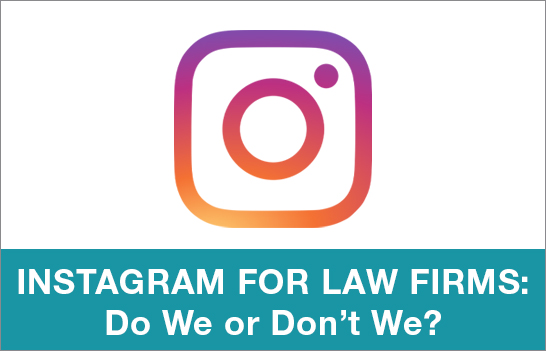Instagram for Law Firms: Do We or Don’t We?
Most big brands will attest to the powerful branding tool that is Instagram. However, we’re often asked whether Instagram is a good platform for law firms. While it is up to each firm, practice and attorney to evaluate Instagram’s fit in their marketing mix, several in-house legal professionals recently discussed how their law firms are finding success on Instagram during the Legal Marketing Association’s Social & Digital Media SIG webcast in February. Check out these top takeaways from speakers Emily Brooks, Marketing Specialist at Fenwick & West LLP; Andrew Farmer, Global Recruiting Communications Manager at White & Case LLP; and Allison Frazier, Communications Director at Sodoma Law.
Who:
As with any channel a law firm vets, it is important to know your audience – who you should be reaching and where you can find them. 60% of global Instagram users fall within the age range of 18-29 years old, making this platform an easy target for law firms to connect with junior talent both for recruiting and business development, as well as companies known to have younger executives, such as the tech industry.
Why:
Speakers agreed that Instagram primarily supports brand building, awareness, and engagement. It humanizes a law firm and its people by providing an insider’s view into the life of a law firm, which in turn conveys the firm’s culture. This approach can help law firms connect with a wide range of users on shared values.
Because Instagram offers multiple media types in addition to photos, such as video and boomerang, posts tend to be fun and engaging. Allison pointed out that people generally associate fun with approachability, which can help law firms counter the traditional perspective that they are stuffy and unapproachable.
How:
Approach Instagram as a platform for a different type of conversation than other social media and take a different approach. Where many social channels are very copy driven, Instagram forces you to tell a visual story making it a great platform to promote pro bono and corporate social responsibility (CSR).
Speakers agreed that using templates can ensure brand consistency and create greater efficiency. Consider a website like Canva, which is user-friendly and customizable for graphics and text.
Employee engagement helps employees feel involved and get excited about social media and can help keep a law firm’s content fresh and diverse.
And, speakers suggested strategically using hashtags to help users find your content.
Measure:
Measurements should be identified based on your goals. Emily says in addition to quantitative data, such as likes and shares, it is important to collect and share success stories as well.
